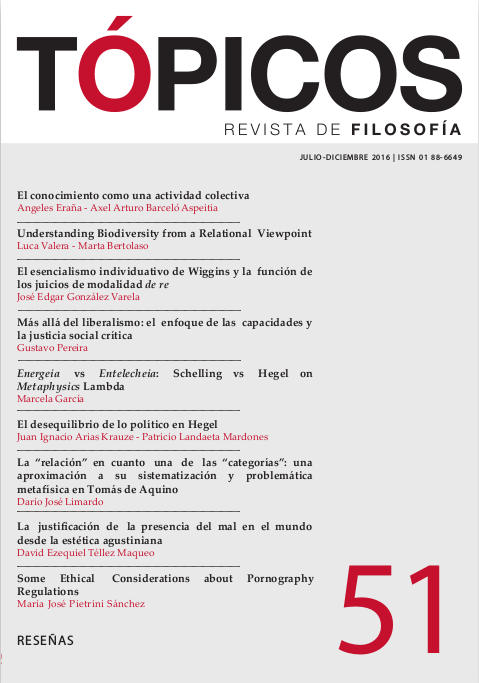Published 2016-07-01
Keywords
- evil,
- augustinian philosophy,
- aesthetics,
- medieval philosophy
How to Cite
Abstract
The possibility of a philosophical reconciliation between God as an absolute principle of goodness and evil in the present reality through its various manifestations (poverty, war, disease, ignorance, etc.), has been a constant concern in the History of Western thought. If God exists, how can it be that there is evil in the world? To give a satisfactory rational response, different answers have been proposed. But Augustine of Hippo represents one of the first dominant responses of Western History so that the knowledge of his position concerning this issue is worthy of further analysis. Thus, the aim of these lines is three fold: (1) to define which is the aesthetic solution of Augustine to the problem of evil, (2) to point out some well known critiques to his position in the twentieth century, (3) to remark that the Augustinian solution, being not utterly satisfactory, can still be the basis for a theodicy that is able to armonize the existence of God and Evil in the world, having previously assessed the different positions made by his critics.
References
- Agustín de Hipona. (2010). Confesiones. Madrid: B.A.C.
- ____ (1969). Obras: vol. 1, Del orden. Madrid: B.A.C.
- ____ (1968). Obras: vol. 16, La ciudad de Dios. Madrid: B.A.C.
- ____ (1963). Obras: vol. 3, Contra los académicos-Del libre albedrío-De la cantidad del alma-Del maestro-Del alma y su origen-De la naturaleza del bien: contra los maniqueos. Madrid: B.A.C.
- ____ (1956). Obras: vol. 4, De la verdadera religión, De las costumbres de la Iglesia-Enquiridión-De la fe en lo que no se ve-De la utilidad de creer. Madrid: B.A.C.
- ____ (1953). Obras: vol. 11, Cartas (2°). Madrid: B.A.C.
- Aquino, T. (2015). Cuestiones disputadas sobre el mal. Pamplona: Eunsa.
- ____ (2001). Suma de Teología. Vol. 1: Parte I. Madrid: B.A.C.
- ____ (1995). Suma de Teología. Vol. 3: Parte II-II (a). Madrid: B.A.C.
- ____ (1994). Suma de Teología. Vol. 4: Parte II-II (b). Madrid: B.A.C.
- ____ (1953). Expositio super epistolam Pauli ad Corinthios. Roma Taurini: Marietti.
- Brachtendorf, J. (2000). The Goodness of Creation and the Reality of Evil: Suffering as a Problem in Augustine’s Theodicy. Augustinian Studies, 31, 79-92.
- Burt, D. X. (1990). Courageous Optimism: Augustine on the Good of Creation. Augustinian Studies, 21, 55-66.
- Bychkov, O. (1996). The Reflection of Some Traditional Stoic Ideas in the Thirteenth-Century Scholastic Theories of Beauty. Vivarium, 34, 141-160.
- Chapman, E. (1941). Some Aspects of St. Augustine’s Philosophy of Beauty. The Journal of Aesthetics and Art Criticism, I, 46-51.
- Clark, S. R. L. (2004). Progress and the Argument from Evil. Religious Studies, 40 (2), 181-192.
- Griffin, D. (1976). God, Power and Evil: A Process Theodicy. Philadelphia: Westminster.
- Harnack, A. (1958). History of Dogma. Vol. 5. Nueva York: Rusell & Rusell. Hick, J. (1977). Evil and the God of Love. Nueva York: Harper and Row.
- Latzer, M. (1993). The Nature of Evil: Leibniz and His Medieval Background. Modern Schoolman, 71, 59-69.
- Lovejoy, A. (1939). The Great Chain of Being. A Study of the History of an Idea. Cambridge MA.: Harvard University Press.
- Matthews, W. (1982). El neoplatonismo como solución agustiniana al problema del mal. Augustinus, 27 (192), 339-356.
- ____ (1994). Did St. Augustine abandon Neoplatonism as a Solution for the Problem of Evil? Journal of Neoplatonic Studies, 3, 3-47.
- Neumann de Paulo, Craig J.- Conroy de Paulo, C. (2004). Reflexiones sobre la postura agustiniana respecto a la prostitución. Augustinus, 49, 27-34.
- Nicolás de Cusa. (1980). Apología de la docta ignorancia: Escoto Eriugena-Nicolás de Cusa. En Los filósofos medievales. Vol. II. Fernández, C. (Ed.) Madrid: B.A.C.
- Nunes Costa, M. R. (2008). Ordem, Harmonia e Perfeicao do Universo na Filosofia da Natureza de Santo Agostinho. Revista Portuguesa de Filosofia, 64, 195-207.
- Pedraz, J. (1975). Cristianos en busca de respuestas. Santander: Sal Terrae.
- Ratzinger. (2002). The Feeling of Things, the Contemplation of Beauty. Meeting de Rimini por la amistad entre los pueblos. Rimini: Congregación para la doctrina de la fe.
- Schäfer, C. (2000). Augustine on Mode, Form, and Natural Order. Augustinian Studies, 31, 59-77.
- Sohn, H. (2007). The Beauty of Hell? Augustine’s Aesthetic Theodicy and Its Critics. Theology Today, 64, 47–57.
- ____ (2009). God in Aesthetic Evolution: Whitehead’s AestheticnTheodicy of Adventure. The Heytrop Journal, 50, 819-832.
- Steel, C. (1994). Does Evil Have a Cause? Augustine’s Perplexity and Thomas’ Answer. Review of Metaphysics, 48 (2), 251-273.
- Thompson, S. E. (2012). What Goodness Is: Order as Imitation of Unity in Augustine. Review of Metaphysics, 65 (3), 525-553.
- Williams, R. (2000). Insubstantial Evil. En Augustine and his Critics. R. Dodaro & G. Lawless (Eds.) (105-122). London: Routledge.
- Whitehead, A. N. (1933). Adventures of Ideas. Nueva York: Macmillan.
- ____ (1925). Science and the Modern World. Nueva York: Macmillan.
- Whitney, B. (1994). An Aesthetic Solution to the Problem of Evil. International Journal for Philosophy of Religion, 35, 21-37.






